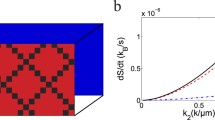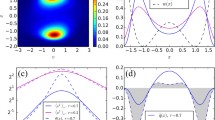Abstract
Understanding the statistical behavior of the heat in stochastic systems gives us insight into the thermodynamics of such systems. Using the recently proposed relativistic stochastic thermodynamics, we investigate the statistics of the heat of a Relativistic Ornstein–Uhlenbeck particle, comparing with the classical case. The results are exact through numerical integration of the Fokker–Planck of the joint distribution, and are validated by numerical simulations.
Graphic abstract










Similar content being viewed by others
Data Availibility Statement
This manuscript has no associated data or the data will not be deposited. [Authors’ comment: The simulations described in the article were made with very standard software, some of it provided by PUC-Rio.]
References
S. Carnot, Reflections on the Motive Power of Fire: And Other Papers on the Second Law of Thermodynamics (Courier Corporation, New York, 2012)
M.J.D. Oliveira, Rev. Bras. Ensino Fís. 42, e20200210 (2020). ((ISSN 1806-1117, 1806-9126))
S. Ciliberto, Phys. Rev. X 7, 021051 (2017). https://doi.org/10.1103/PhysRevX.7.021051 ((publisher: American Physical Society))
U. Seifert, Rep. Prog. Phys. 75, 126001 (2012)
K. Sekimoto, Stochastic Energetics, vol. 799 (Springer, Berlin, 2010)
P. V. Paraguassú, R. Aquino, W.A.M. Morgado, arXiv:2102.09115 [cond-mat]. http://arxiv.org/abs/2102.09115 (2021)
P.V. Paraguassú, W.A.M. Morgado, J. Stat. Mech. 2021, 023205 (2021). https://doi.org/10.1088/1742-5468/abda25 ((ISSN 1742-5468 publisher: IOP Publishing))
D. Gupta, D.A. Sivak, arXiv:2103.09358 [cond-mat]. http://arxiv.org/abs/2103.09358 (2021)
H.C. Fogedby, J. Stat. Mech. 2020, 083208 (2020). https://doi.org/10.1088/1742-5468/aba7b2 ((ISSN 1742-5468 publisher: IOP Publishing))
K. Goswami, Phys. Rev. E 99, 012112 (2019). https://doi.org/10.1103/PhysRevE.99.012112 ((publisher: American Physical Society))
A. Crisanti, A. Sarracino, M. Zannetti, Phys. Rev. E 95, 052138 (2017). https://doi.org/10.1103/PhysRevE.95.052138 ((publisher: American Physical Society))
A. Ghosal, B.J. Cherayil, J. Stat. Mech. 2016, 043201 (2016). https://doi.org/10.1088/1742-5468/2016/04/043201 ((ISSN 1742-5468 publisher: IOP Publishing))
M.L. Rosinberg, G. Tarjus, T. Munakata, EPL 113, 10007 (2016). https://doi.org/10.1209/0295-5075/113/10007 ((ISSN 0295-5075 publisher: IOP Publishing))
K. Kim, C. Kwon, H. Park, Phys. Rev. E 90, 032117 (2014). https://doi.org/10.1103/PhysRevE.90.032117 ((ISSN 1539-3755, 1550-2376))
Kuśmierz, J.M. Rubi, E. Gudowska-Nowak, J. Stat. Mech. 2014, P09002 (2014). https://doi.org/10.1088/1742-5468/2014/09/p09002 ((ISSN 1742-5468 publisher: IOP Publishing ))
B. Saha, S. Mukherji, J. Stat. Mech. 2014, P08014 (2014). https://doi.org/10.1088/1742-5468/2014/08/P08014 ((ISSN 1742-5468))
D. Chatterjee, B.J. Cherayil, J. Stat. Mech. 2011, P03010 (2011). https://doi.org/10.1088/1742-5468/2011/03/P03010 ((ISSN 1742-5468))
D. Chatterjee, B.J. Cherayil, Phys. Rev. E 82, 051104 (2010). https://doi.org/10.1103/PhysRevE.82.051104 ((ISSN 1539-3755, 1550-2376))
H.C. Fogedby, A. Imparato, J. Phys. A Math. Theor. 42, 475004 (2009). https://doi.org/10.1088/1751-8113/42/47/475004 ((ISSN 1751-8121))
A. Imparato, P. Jop, A. Petrosyan, S. Ciliberto, J. Stat. Mech. 2008, P10017 (2008). https://doi.org/10.1088/1742-5468/2008/10/P10017 ((ISSN 1742-5468))
A. Imparato, L. Peliti, G. Pesce, G. Rusciano, A. Sasso, Phys. Rev. E 76, 050101 (2007). https://doi.org/10.1103/PhysRevE.76.050101 ((publisher: American Physical Society))
S. Joubaud, N.B. Garnier, S. Ciliberto, J. Stat. Mech. 2007, P09018 (2007). https://doi.org/10.1088/1742-5468/2007/09/p09018 ((ISSN 1742-5468 publisher: IOP Publishing))
P.S. Pal, S. Deffner, New J. Phys. 22, 073054 (2020). https://doi.org/10.1088/1367-2630/ab9ce6 ((ISSN 1367-2630))
E.T. Meyer, Nat. Astron. 2, 32–33 (2018)
T. Koide, T. Kodama, Phys. Rev. E 83, 061111 (2011). https://doi.org/10.1103/PhysRevE.83.061111 ((ISSN 1539-3755, 1550-2376))
Y. Akamatsu, T. Hatsuda, T. Hirano, Phys. Rev. C 79, 054907 (2009). https://doi.org/10.1103/PhysRevC.79.054907 ((ISSN 0556-2813, 1089-490X))
A. Pototsky, F. Marchesoni, F.V. Kusmartsev, P. Hänggi, S.E. Savel’ev, Eur. Phys. J. B 85, 356 (2012). https://doi.org/10.1140/epjb/e2012-30716-7 ((ISSN 1434-6028, 1434-6036))
A. Pototsky, F. Marchesoni, Phys. Rev. E 87, 032132 (2013). https://doi.org/10.1103/PhysRevE.87.032132 ((ISSN 1539-3755, 1550-2376))
J. Dunkel, P. Hänggi, Phys. Rev. E 71, 016124 (2005). https://doi.org/10.1103/PhysRevE.71.016124 ((ISSN 1539-3755, 1550-2376))
J. Dunkel, P. Hänggi, Phys. Rev. E 72, 036106 (2005). https://doi.org/10.1103/PhysRevE.72.036106 ((ISSN 1539-3755, 1550-2376))
J. Dunkel, P. Hänggi, Phys. Rep. 471, 1–73 (2009). ((ISSN 03701573))
B. Lindner, New J. Phys. 9, 136–136 (2007). https://doi.org/10.1088/1367-2630/9/5/136 ((ISSN 1367-2630))
F. Debbasch, K. Mallick, J.P. Rivet, J. Stat. Phys. 88, 945–966 (1997). https://doi.org/10.1023/B:JOSS.0000015180.16261.53 ((ISSN 1572-9613))
F. Debbasch, D. Espaze, V. Foulonneau, J.P. Rivet, Phys. A Stat. Mech. Appl. 391, 3797–3804 (2012). ((ISSN 03784371))
B.U. Felderhof, Phys. Rev. E 86, 061103 (2012). https://doi.org/10.1103/PhysRevE.86.061103 ((ISSN 1539-3755, 1550-2376))
S. Deffner, A. Saxena, Phys. Rev. E 92, 032137 (2015)
H.P. Langtangen, A. Logg, Solving PDEs in Python: The FEniCS Tutorial I (Springer Nature, Basingstoke, 2016)
H. Risken, Fokker–Planck Equation (Springer, Berlin, 1996), pp. 63–95
L. Onsager, S. Machlup, Phys. Rev. 91, 1505 (1953)
M.V. Moreno, D.G. Barci, Z.G. Arenas, Phys. Rev. E 99, 032125 (2019). https://doi.org/10.1103/PhysRevE.99.032125 ((ISSN 2470-0045, 2470-0053))
H.S. Wio, Path Integrals for Stochastic Processes: An Introduction (World Scientific, Singapore, 2013)
M. Chaichian, A. Demichev, Path Integrals in Physics: Volume I Stochastic Processes and Quantum Mechanics (CRC Press, Boca Raton, 2018)
D. Cubero, J. Casado-Pascual, J. Dunkel, P. Talkner, P. Hänggi, Phys. Rev. Lett. 99, 170601 (2007). https://doi.org/10.1103/PhysRevLett.99.170601 ((ISSN 0031-9007, 1079-7114))
P.G.D. Gennes, J. Stat. Phys. 119, 953–962 (2005). https://doi.org/10.1007/s10955-005-4650-4 ((ISSN 0022-4715, 1572-9613))
A. Logg, K.A. Mardal, G. Wells, Automated Solution of Differential Equations by the Finite Element Method: The Fenics Book, vol. 84 (Springer Science & Business Media, Berlin, 2012)
M.L. Rosinberg, G. Tarjus, T. Munakata, Phys. Rev. E 95, 022123 (2017). https://doi.org/10.1103/PhysRevE.95.022123 ((ISSN 2470-0045, 2470-0053))
T. Munakata, M.L. Rosinberg, J. Stat. Mech. 2012, P05010 (2012). https://doi.org/10.1088/1742-5468/2012/05/P05010/meta ((ISSN 1742-5468 publisher: IOP Publishing))
A.V. Plyukhin, Phys. Rev. E 88, 052115 (2013). https://doi.org/10.1103/PhysRevE.88.052115 ((ISSN 1539-3755, 1550-2376))
S.M. Blinder, Phys. Rev. A 37, 973–976 (1988). https://doi.org/10.1103/PhysRevA.37.973 ((publisher: American Physical Society))
R.E. Crandall, J. Phys. A Math. Gen. 26, 3627–3648 (1993). https://doi.org/10.1088/0305-4470/26/14/024 ((ISSN 0305-4470 publisher: IOP Publishing))
M.J. Goovaerts, A. Babcenco, J.T. Devreese, J. Math. Phys. 14, 554–559 (1973). https://doi.org/10.1063/1.1666355 ((ISSN 0022-2488 publisher: American Institute of Physics))
S.V. Lawande, K.V. Bhagwat, Phys. Lett. A 131, 8–10 (1988). ((ISSN 0375-9601))
Acknowledgements
We would like to thank Juan Leite, Luciano Defaveri, Igor Brandão, and Victor Alencar for useful discussions. This work is supported by the Brazilian agencies CAPES and CNPq. P.V.P. would like to thank CNPq for his current fellowship. This study was financed in part by Coordenação de Aperfeiçoamento de Pessoal de Nível Superior—Brasil (CAPES)—Finance Code 001.
Author information
Authors and Affiliations
Contributions
PVP (graduate student under supervision by WAMM) contributed with most of the ideas, calculations and writings (75%). WAMM contributed with ideas, discussions, and text corrections and adjustment (25%).
Corresponding author
Appendix A: Path integral for ultra-relativistic case
Appendix A: Path integral for ultra-relativistic case
In Eq. 10 the conditional probability can be derived by means of the path integral technique. Which states that
where \({\mathcal {A}}[p(t)]\) is the stochastic action [40,41,42], in the Stratonovich prescription is given by
where \(D=\gamma T\). By noticing that \(p/|p|=\text {sign}(p)=2H(p)-1\) and \(H'(p)=\delta (p)\), we can rewrite the action as
where, \(\alpha =4D\gamma c\). The conditional probability can be rewritten as
where \(K[p_t,t|p_0]\) will be the path integral
which has the same structure of a quantum mechanical propagator of a particle with a delta potential [49,50,51,52]. Thus, following [52] we review the derivation of this path integral.
To solve Eq. (A5) we expand the potential, obtaining
where
Therefore, we only have to solve \(K_1\). To do this, note that
where in the second line, we just reordered the time. The path integral in K is a Wiener path integral that describes a Markovian stochastic process, thus we have the property
therefore, in \(K_1\) we have the expression
Thus, we have
Note that we have convolutions between the propagators. Then, by making the Laplace’s transform
we can get rid of the time integrals, giving
where
then
The above sum is solved exactly, since \(\sum _{n=1}^\infty (a)^n = a/(a-1)\), and then we can use the inverse Laplace transform to find the desired \(K_1\).
where \({\mathcal {L}}^{-1}\) is the inverse Laplace transform. Note that
Thus, using the above formula, \(K_1\) becomes
Therefore, we have
and finally the conditional probability
Note that this distribution recovers the equilibrium one for \(t\rightarrow \infty \), that is
as it should be.
Rights and permissions
About this article
Cite this article
Paraguassú, P.V., Morgado, W.A.M. Heat distribution of relativistic Brownian motion. Eur. Phys. J. B 94, 197 (2021). https://doi.org/10.1140/epjb/s10051-021-00214-8
Received:
Accepted:
Published:
DOI: https://doi.org/10.1140/epjb/s10051-021-00214-8




